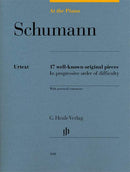| 作曲者 | Robert Schumann (1810-1856)・ロベルト・シューマン |
| タイトル | At The Piano - Schumann |
| サブタイトル | 17 well-known original pieces in progressive order of difficulty with practical comments |
| 出版社 | G. Henle Verlag・ヘンレ |
| 楽器編成 | piano |
| 品番 | 9790201818184 |
| 校訂者 | Sylvia Hewig-Troescher |
| 言語 | 英語 |
| 形状 | 240 g |
| 出版番号 | HN 1818 |
| ISMN | 979-0-2018-1818-4 |
Schumann was a poet at the piano, and the best known of his piano pieces bear programmatic titles such as “Träumerei” (“Reverie”), “Von fremden Ländern und Menschen” (“Of foreign lands and people”) or “Vogel als Prophet” (“The bird as prophet”). His whole oeuvre exudes a sense of poetic freedom, making him the Romantic composer par excellence. Whether in his easiest pieces for children from his Album for the Young or in the more demanding Papillons, we can hear Schumann’s own distinctive voice everywhere – a voice whose many registers can be experienced in this selection, which ranges from the easy to the moderately difficult.
Wiegenliedchen op. 124 Nr. 6 aus Albumblätter op. 124 - Volksliedchen op. 68 Nr. 9 aus Album für die Jugend op. 68 - Von fremden Ländern und Menschen op. 15 Nr. 1 aus Kinderszenen op. 15 - Curiose Geschichte op. 15 Nr. 2 aus Kinderszenen op. 15 - Ziemlich langsam (Albumblatt Nr. I fis-moll) op. 99 Nr. 4 aus Bunte Blätter op. 99 - Nachklänge aus dem Theater op. 68 Nr. 25 aus Album für die Jugend op. 68 - Träumerei op. 15 Nr. 7 aus Kinderszenen op. 15 - Zwei Intermezzi op. 4 Nr. 3 und Nr. 4 aus Intermezzi op. 4 - Romanze g-moll op. 26 Nr. 2 aus Faschingsschwank aus Wien op. 26 - Romanze Fis-dur op. 28 Nr. 2 aus Drei Romanzen op. 28 - Pierrot op. 9 Nr. 2 aus Carnaval op. 9 - Valse noble op. 9 Nr. 4 aus Carnaval op. 9 - Des Abends op. 12 Nr. 1 aus Fantasiestücke op. 12 - Warum? op. 12 Nr. 3 aus Fantasiestücke op. 12 - Vogel als Prophet op. 82 Nr. 7 aus Waldszenen op. 82 - Arabeske C-dur op. 18 - Papillons op. 2 Nr. 5, 6 und 12



